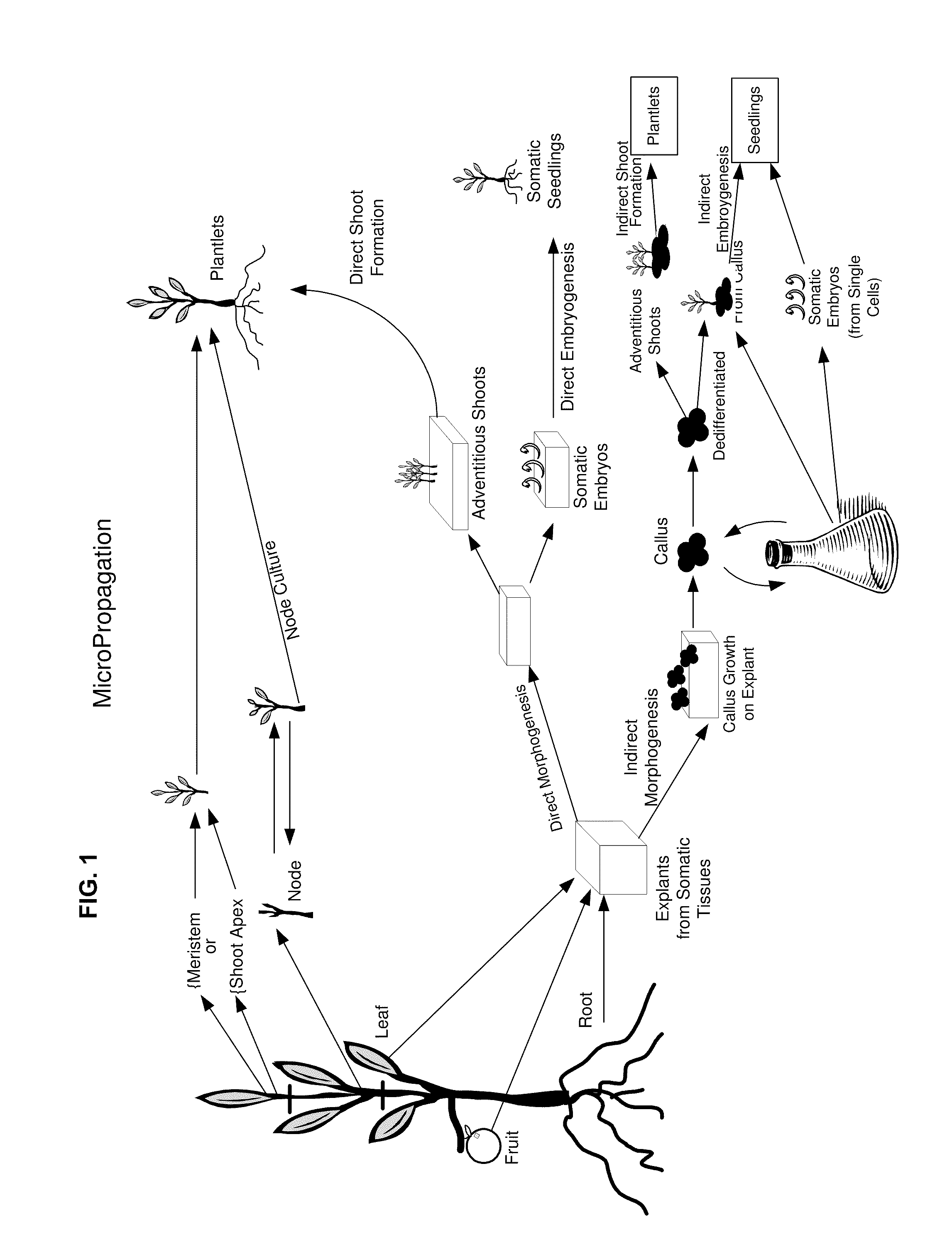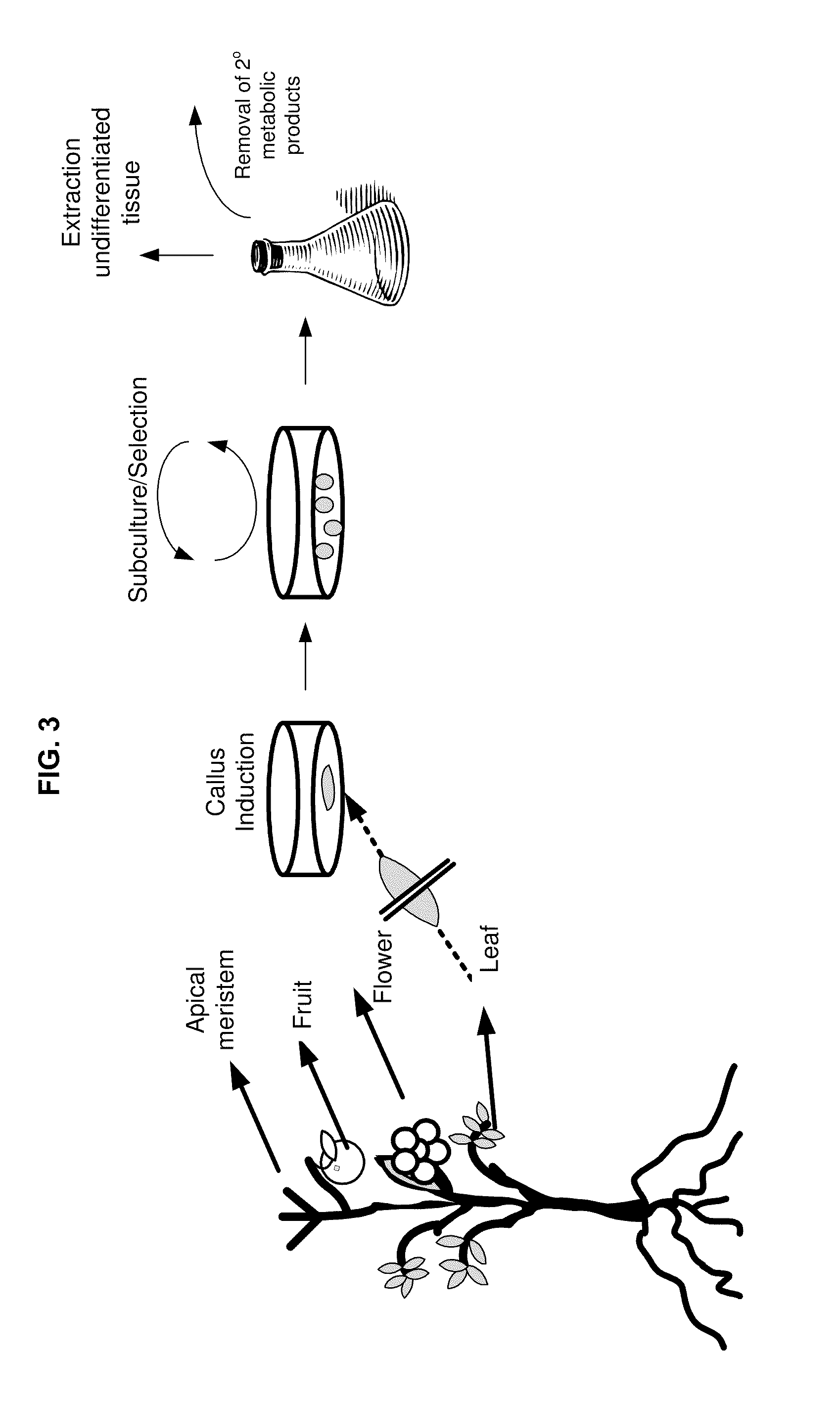Methods and compositions for identifying, producing and using plant-derived products for modulating cell function and aging
- Summary
- Abstract
- Description
- Claims
- Application Information
AI Technical Summary
Benefits of technology
Problems solved by technology
Method used
Image
Examples
example 1
Base Methodology for Production of Plant Tissue Culture
[0322]This example provides a general overview of guidelines for handling plant tissue for producing tissue culture. Specific methods are provided in later examples.
[0323]General Plant Cell Culture: Generally, the “youngest” original tissue is selected as juvenile tissue tends to be less contaminated and often readily forming callus tissue. For instance, for orchids, using protocorm tissue for generation of callus tissue may be the fastest route. Protocorms are beneficially used before they develop root or shoot, and the dark green protocorms should be selected (as clear or pale protocorms are generally unhealthy. An orbital shaker is useful to reduce any influence gravity might have on the cells, and low speed is generally recommended in order to keep to a minimum shearing and impact stress to the cells. For solid cultures, 45 degree slants are used; this permits maximum air exchange. If cultures need to be kept in the dark, th...
example 2
Acai Palm (Euterpe oleracea) Seed Culture
[0328]Euterpe oleracea seed were prepped as follows for sterile culture: Seed (obtained from Brazil) was already germinated when received. Husk hairs were removed, then seeds were surface sterilized by putting 6 seeds in 3% hydrogen peroxide for 10 minutes. The seeds were not rinsed. Alternatively, the full (including furry seed coat) berry was treated in 50% bleach+Tween 20 for 20 minutes, or 10% bleach+Tween 20 for 60 minutes. The seed coat and any “shoots” were removed and the berry was treated a second time with 10% bleach+Tween 20 for 2 minutes. The berries were then placed into culture per basic methodology.
[0329]Tubes were filled with Stage 1 gel medium {M527 Phytotechnology: Murashige Modified Multiplication Basal Medium} and sterilized. Germinated seed was transferred to the slants (1 seed / tube). Tubes were capped and wrapped with parafilm. One seed was placed in each of 6 tubes. Tubes were labeled with the seed name, method of steri...
example 3
Alaska Blueberry (Vaccinium alaskensis) Seed Culture
[0331]Vaccinium alaskensis seed were prepped as follows for germination: Seed (obtained from Alaska Blues, LLC Calder Mt. Tongass Nat'l Rain Forest, Alaska) was surface sterilized in 3% hydrogen peroxide for 5 minutes. The hydrogen peroxide was removed by a vacuum pump and a filter sterilization unit. Seed was rinsed with sterile deionized water and vacuum pumped to dry. Alternatively, seed were treated with 5% bleach (Clorox) for 70 minutes, then rinsed.
[0332]Tubes were filled with Stage 1 gel medium {M527 Phytotechnology: Murashige Modified Multiplication Basal Medium} and sterilized. Seed was transferred to the slants (1 seed / tube). Tubes were capped and wrapped with parafilm, than labeled with the seed name, method of sterilization, and date of culturing. Tubes were stored at room temperature.
[0333]Six seedlings that were treated with 10% Clorox for 15 minutes are growing poorly on MS stage 1 gel slants; they germinated in two ...
PUM
| Property | Measurement | Unit |
|---|---|---|
| Volume | aaaaa | aaaaa |
| Volume | aaaaa | aaaaa |
| Volume | aaaaa | aaaaa |
Abstract
Description
Claims
Application Information
 Login to View More
Login to View More - R&D
- Intellectual Property
- Life Sciences
- Materials
- Tech Scout
- Unparalleled Data Quality
- Higher Quality Content
- 60% Fewer Hallucinations
Browse by: Latest US Patents, China's latest patents, Technical Efficacy Thesaurus, Application Domain, Technology Topic, Popular Technical Reports.
© 2025 PatSnap. All rights reserved.Legal|Privacy policy|Modern Slavery Act Transparency Statement|Sitemap|About US| Contact US: help@patsnap.com



